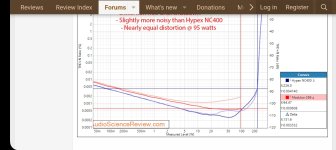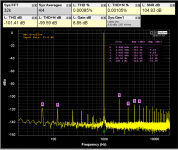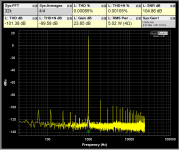what graph are you referring to?whereas the -90 dB you had before that for 5 W / 4 R is more what I would expect for a 3886 with carefully balanced impedances but no additional loop gain.
Last edited:
If you compare these results with Modulus 286 measured by Audiosciencereview they are very similar. See the harmonics at 5w kHz, they are identical to yours.4R load results are good but not as good as 8R.
Even though THD+N is way better that of the datasheet, I am still far from achieving the level of performance of the Modulus line of amplifiers.
Note how 2nd harmonics is dominant in all of the measurements.
Looks like VAS stage is running out of juice (distorting) earlier then output devices.
By using four LM3886s output stage is equivalent to four pairs of output transistors or 2EF-4.
Attachments
the first one in post #22 for examplewhat graph are you referring to?
@ HAYK: but the Modulus 286 is a composite amp. I don't get how the same can be achieved without the extra loop gain.
If you look the DS 8 ohms,
https://www.diyaudio.com/community/...lifiers-aka-modulus-clone.408330/post-7627052
100mw 1khz, it is 0.001%. If 2 chips are paralleled, than you get it with 4 ohms. Modulus 286 measures 0.0005%, halved only thanks to error corrector. Our brave OP gets the same halved by using lower gain and 2wise more chips.
https://www.diyaudio.com/community/...lifiers-aka-modulus-clone.408330/post-7627052
100mw 1khz, it is 0.001%. If 2 chips are paralleled, than you get it with 4 ohms. Modulus 286 measures 0.0005%, halved only thanks to error corrector. Our brave OP gets the same halved by using lower gain and 2wise more chips.
The Modulus amps are not composite as a diagram shows, it is error corrected with input buffer. See the circuit.the first one in post #22 for example
@ HAYK: but the Modulus 286 is a composite amp. I don't get how the same can be achieved without the extra loop gain.
https://www.diyaudio.com/community/...lifiers-aka-modulus-clone.408330/post-7580875
You'll also notice the comment about power supply noise in ASR's picture. I measure close to -120 dBc THD at 5 W on the MOD286 with a better power supply.If you compare these results with Modulus 286 measured by Audiosciencereview they are very similar. See the harmonics at 5w kHz, they are identical to yours.
The plots in Post #41 show about -105 dBc. The extra 15 dB takes real work to obtain.
Tom
It can't. HAYK isn't comparing apples to apples.I don't get how the same can be achieved without the extra loop gain.
Tom
the first one in post #22 for example
The whole measurement was not adjusted for the input gain and if you look at the 0dBu you can see that the signal is higher at about 15dBu.
I posted adjusted graph next to it where the top of the 1khz tone is exactly at 0dbu.
Below are attached two same graphs, except one is scaled to 0dbu
Second harmonic is below -100dBu
Attachments
Last edited:
The harmonic levels cannot be effected by the power supply noise and they are the same as the OP is measuring.and confirmed. Despite error corrector, the Power supply rejection ratio is very bad. On the other hand you are giving the same THD+N for 8 ohms and 4 ohms at 10mw is very doubtful for the exactitude of your measurements.You'll also notice the comment about power supply noise in ASR's picture. I measure close to -120 dBc THD at 5 W on the MOD286 with a better power supply.
The plots in Post #41 show about -105 dBc. The extra 15 dB takes real work to obtain.
Tom
Maybe a noob can get such results if he will be measuring with an ultra low noise power supply on 29 Feb between 4 and 7 pm at Calgary temperatures of -35°C.
Last edited:
pbilous can you post the full schematic?
From my previous thread four chip version subtracted stability Cin and RC over feedback resistor :
https://www.diyaudio.com/community/...rvo-circuit-build-attempt.383676/post-7286957
post #220
Last edited:
If you compare these results with Modulus 286 measured by Audiosciencereview they are very similar. See the harmonics at 5w kHz, they are identical to yours.
View attachment 1286549
ASR was reviewing prototype for Modulus-286, but I wonder how the current production version with the new case and linear PSU will measure?
Modulus-686 probably measures even better.
My amplifier clears -100dB 0.001% THD+N 1khz and I am happy with that. Second harmonic is dominant wich is an extra bonus. 10khz is around -86dB 0.005% THD+N but is usually like that.
I have Modulus-86 and now I am curious to do listening tests side by side and compare the two.
It is not a prototype but a $1300 version.
https://audiosciencereview.com/foru...urements-of-neurochrome-modulus-286-amp.6443/
See also topping LA90 with 3886.
https://audiosciencereview.com/foru...pping-la90-review-integrated-amplifier.33374/.
Why you don't measure the Modulus 86 too.
https://audiosciencereview.com/foru...urements-of-neurochrome-modulus-286-amp.6443/
See also topping LA90 with 3886.
https://audiosciencereview.com/foru...pping-la90-review-integrated-amplifier.33374/.
Why you don't measure the Modulus 86 too.
Well, your link shows another approach. Even if you call it Modulus clone it ain't. The Modulus amps clearly are composite amps.The Modulus amps are not composite as a diagram shows, it is error corrected with input buffer. See the circuit.
https://www.diyaudio.com/community/...lifiers-aka-modulus-clone.408330/post-7580875
Analog Devices say: "A composite amplifier is an arrangement of two individual amplifiers configured in such a way as to realize the benefits of each individual amplifier while diminishing the drawbacks of each amplifier."The Modulus amps are not composite as a diagram shows, it is error corrected with input buffer. See the circuit.
https://www.diyaudio.com/community/...lifiers-aka-modulus-clone.408330/post-7580875
Which is exactly what happens in the Modulus amps or in any of your amp proposals you've posted here lately, no matter if you call something "error corrected only".
Where did they write "gets influenced"?
You have two opamps, one amp with high power/voltage but low precision and one small-signal amp with high precision but low power/voltage. The composite yields a power amp with high precision, exactly combining the benefits of each, power from the first and precision from the second.
You have two opamps, one amp with high power/voltage but low precision and one small-signal amp with high precision but low power/voltage. The composite yields a power amp with high precision, exactly combining the benefits of each, power from the first and precision from the second.
The one you sent me was the block diagram for the Modulus v2 that used to be on the Neurochrome homepage, but this is virtually identical: https://neurochrome.com/products/modulus-86 (go to tab "circuit topology").The circuit shown is not mine it is given with Modulus-86 board. I'll give you the source on your private mail because of copyright.
I have the discontinued parallel 86 which came with a schematic, and I can assure you it is a composite amp. The 3886 has its own local feedback (gain of ~20 AFAIR), and there is another loop that includes the op amp. The op amp output is attenuated to keep it stable.
- Home
- Amplifiers
- Chip Amps
- Another LM3886 in parallel attempt - this time 4 of them!


